Seabed Morphology and Sedimentary Regimes defining Fishing Grounds along the Eastern Brazilian Shelf
Abstract
:1. Introduction
2. Materials and Methods
2.1. Study Area
2.2. Data Acquisition
2.2.1. Acoustic Imaging
2.2.2. Sub-Bottom Profiling
2.2.3. Sediment Sampling
2.3. Shelf Morphology Analysis
3. Results
3.1. Shelf Geomorphology
3.2. Morpho-Sedimentary Facies—Physical Habitats
3.2.1. Terrigenous Mud
3.2.2. Terrigenous Sand
3.2.3. Rhodolith Beds
3.2.4. Bioclastic Gravel with Rhodoliths
3.2.5. Coastal Hardground
3.3. Fishing Activities
4. Discussion
5. Conclusions
Acknowledgments
Author Contributions
Conflicts of Interest
References
- Catuneanu, O. Principles of Sequence Stratigraphy; Elsevier Science: Amsterdam, The Netherlands, 2006; p. 386. [Google Scholar]
- Cowell, P.J.; Thom, B.G. Morphodynamics of coastal evolution. In Coastal Evolution: Late Quaternary Shoreline Morphodynamics; Carter, R.W.G., Woodroffe, C.D., Eds.; University Press: Cambridge, UK, 1994; p. 540. [Google Scholar]
- Sternberg, R.; Nowell, A.R.M. Continental shelf sedimentology: Scales of investigation define future research opportunities. J. Sea Res. 1999, 41, 55–71. [Google Scholar] [CrossRef]
- Harris, P.T.; Baker, E.K. 1—Why Map Benthic Habitats? In Seafloor Geomorphology as Benthic Habitat; Elsevier: London, UK, 2012; pp. 3–22. [Google Scholar]
- Swift, D.J.P.; Phillips, S.; Thorne, J.A. Sedimentation on Continental Margins, IV: Lithofacies and depositional systems. In Shel and Sandstone Bodies: Geometry, Facies and Sequence Stratigraphy; Swift, D.J.P., Oertel, G.F., Tillman, R.W., Thorne, J.A., Eds.; Wiley: Hoboken, NJ, USA, 1991; pp. 89–152. [Google Scholar]
- Nichol, S.L.; Brooke, B.P. Shelf habitat distribution as a legacy of Late Quaternary marine transgressions: A case study from a tropical carbonate province. Cont. Shelf Res. 2011, 31, 1845–1857. [Google Scholar] [CrossRef]
- Teixeira, J.B.; Martins, A.S.; Pinheiro, H.T.; Secchin, N.A.; Leão de Moura, R.; Bastos, A.C. Traditional ecological knowledge and the mapping of benthic marine habitats. J. Environ. Manag. 2013, 115, 241–250. [Google Scholar] [CrossRef] [PubMed]
- D’agostini, D.P.; Bastos, A.C.; Dos Reis, A.T. The modern mixed carbonate–siliciclastic abrolhos shelf: Implications for a mixed depositional model. J. Sediment. Res. 2015, 85, 124–139. [Google Scholar] [CrossRef]
- Moura, R.L.; Secchin, N.A.; Amado-Filho, G.M.; Francini-Filho, R.B.; Freitas, M.O.; Minte-Vera, C.V.; Teixeira, J.B.; Thompson, F.L.; Dutra, G.F.; Sumida, P.Y.G.; et al. Spatial patterns of benthic megahabitats and conservation planning in the Abrolhos Bank. Cont. Shelf Res. 2013, 70, 109–117. [Google Scholar] [CrossRef]
- Bastos, A.C.; Quaresma, V.S.; Marangoni, M.B.; D’Agostini, D.P.; Bourguignon, S.N.; Cetto, P.H.; Silva, A.E.; Filho, G.M.A.; Moura, R.L.; Collins, M. Shelf morphology as an indicator of sedimentary regimes: A synthesis from a mixed siliciclasticecarbonate shelf on the eastern Brazilian margin. J. S. Am. Earth Sci. 2015, 125–136. [Google Scholar] [CrossRef]
- Oliveira, K.S.S.; Quaresma, V.S. Temporal variability in the suspended sediment load and streamflow of the Doce River. J. S. Am. Earth Sci. 2017, 78, 101–115. [Google Scholar] [CrossRef]
- Larsonneur, C. La cartographie de’s dépots meubles sur le plateau continental français: Méthode mise du points et utilisée em Manche. J. Recherche Oceanogr. 1977, 2, 34–39. [Google Scholar]
- Wright, D.J.; Pendleton, M.; Boulware, J.; Walbridge, S.; Gerlt, B.; Eslinger, D.; Sampson, D.; Huntley, E. ArcGISBenthic Terrain Modeler (BTM), 3.0; NOAA Coastal Services Center, Massachusetts Office of Coastal Zone Management: Boston, MA, USA, 2012. [Google Scholar]
- Sappington, J.M.; Longshore, K.M.; Thompson, D.B. Quantifying landscape ruggedness for animal habitat analysis: A case study using bighorn sheep in the Mojave Desert. J. Wildl. Manag. 2007, 71, 1419–1426. [Google Scholar] [CrossRef]
- Jerosch, K.; Kuhn, G.; Krajnik, I.; Scharf, F.K.; Dorschel, B. A geomorphological seabed classification for the Weddell Sea, Antarctica. Mar. Geophys. Res. 2016, 37, 127–141. [Google Scholar] [CrossRef] [Green Version]
- Foster, M.S. Rhodoliths: Between Rocks and Soft Places. J. Phycol. 2001, 37, 659–667. [Google Scholar] [CrossRef]
- Pinheiro, H.T.; Martins, A.S. Estudo comparativo da captura artesanal do camarão sete-barbas e sua fauna acompanhante em duas áreas de pesca do litoral do estado do Espírito Santo, Brasil. Bol. Inst. Pesca São Paulo 2009, 35, 215–225. (In Portuguese) [Google Scholar]
- Pinheiro, H.T.; Joyeux, J.C. Pescarias multi-específicas na região da Foz do Rio Doce, ES, Brasil: Características, problemas e opções para um futuro sustentável. Braz. J. Aquat. Sci. Technol. 2007, 11, 15–23. (In Portuguese) [Google Scholar] [CrossRef]
- Netto, R.F.; Beneditto, A.P.M.D. Diversidade de artefatos da pesca artesanal marinha do Espírito Santo. Biotemas 2007, 20, 107–119. (In Portuguese) [Google Scholar]
- Pinheiro, H.T.; Cordeiro Madureira, J.M.; Joyeux, J.-C.; Martins, A.S. Fish diversity of a southwestern Atlantic coastal island: Aspects of distribution and conservation in a marine zoogeographical boundary. Check List 2015, 11, 1–17. [Google Scholar] [CrossRef]
- Posamentier, H.W.; Jervey, M.T.; Vail, P.R. Eustatic Controls on Clastic Deposition I—Conceptual Framework. Soc. Econ. Paleontol. Mineral. Spec. Publ. 1987. [Google Scholar] [CrossRef]
- Posamentier, H.W.; Allen, G.P. Variability of the sequence stratigraphic model: Effects of local basin factors. Sediment. Geol. 1993, 86, 91–109. [Google Scholar] [CrossRef]
- Dominguez, J.M.L. The coastal zone of Brazil. In Geology and Geomorphology of Holocene Coastal Barriers of Brazil; Lecture Notes in Earth Sciences; Sergio, R.D., Hesp, P.A., Eds.; Springer-Verlag: Berlin/Heidelberg, Germany, 2009; pp. 17–51. [Google Scholar]
- Dominguez, J.M.L.; da Silva, R.P.; Nunes, A.S.; Freire, A.F.M. The narrow, shallow, low-accommodation shelf of central Brazil: Sedimentology, evolution, and human uses. Geomorphology 2013, 203, 46–59. [Google Scholar] [CrossRef]
- Araújo, T.C.M.D.; Santos, R.C.D.A.L.; Seoane, J.C.S.; Seoane, J.C.S. Erosão e Progradação do litoral de Alagoas. In Erosão e Progradação do Litoral do Brasil; Muehe, D., Ed.; Minstério de Meio Ambiente: Brasilia, Brazil, 2006; Volume 1, pp. 197–212. (In Portuguese) [Google Scholar]
- Baker, E.K.; Harris, P.T. 2—Habitat Mapping and Marine Management. In Seafloor Geomorphology as Benthic Habitat; Elsevier: London, UK, 2012; pp. 23–38. [Google Scholar]
- Freire, A.F.M.; Dominguez, J.M.L. A seqüência holocênica da plataforma continental central do Estado da Bahia. Bol. Geociênc. Petrobras 2006, 14, 247–267. (In Portuguese) [Google Scholar]
- Amado-Filho, G.M.; Moura, R.L.; Bastos, A.C.; Salgado, L.T.; Sumida, P.Y.; Guth, A.Z.; Francini-Filho, R.B.; Pereira-Filho, G.H.; Abrantes, D.P.; Brasileiro, P.S.; et al. Rhodolith beds are major CaCO3 bio-factories in the tropical South West Atlantic. PLoS ONE 2012, 7, 41–45. [Google Scholar] [CrossRef] [PubMed] [Green Version]
- Milliman, J.D. Role of Calcareous Algae in Atlantic Continental Margin Sedimentation. In Fossil Algae: Recent Results and Developments; Flügel, E., Ed.; Springer: Berlin/Heidelberg, Germany, 1977; pp. 232–247. [Google Scholar]
- Amado-Filho, G.M.; Bahia, R.G.; Pereira-Filho, G.H.; Longo, L.L. South Atlantic rhodolith beds: Latitudinal distribution, species composition, structure and ecosystem functions, threats and conservation status. In Rhodolith/Maërl Beds: A Global Perspective; Riosmena-Rodríguez, R., Nelson, W., Aguirre, J., Eds.; Springer: Boca Raton, FL, USA, 2017; pp. 299–317. [Google Scholar]
- Bahia, R.G.; Abrantes, D.P.; Brasileiro, P.S.; Pereira-Filho, G.H.; Amado-Filho, G.M. Rhodolith bed structure along a depth gradient on the northern coast of bahia state, Brazil. Braz. J. Oceanogr. 2010, 58, 323–337. [Google Scholar] [CrossRef]
- Brasileiro, P.S.; Pereira-Filho, G.H.; Bahia, R.G.; Abrantes, D.P.; Guimarães, S.M.P.B.; Moura, R.L.; Francini-Filho, R.B.; Bastos, A.C.; Amado-Filho, G.M. Macroalgal composition and community structure of the largest rhodolith beds in the world. Mar. Biodivers. 2016, 46, 407–420. [Google Scholar] [CrossRef]
- Amado-Filho, G.; Maneveldt, G.; Pereira-Filho, G.; Manso, R.C.C.; Bahia, R.; Barros-Barreto, M.B.; Guimarães, S. Seaweed diversity associated with a Brazilian tropical rhodolith bed. Cienc. Mar. 2010, 36, 371–391. [Google Scholar] [CrossRef]
- Steller, D.L.; Foster, M.S. Environmental factors influencing distribution and morphology of rhodoliths in Bahía Concepción, BCS, México. J. Exp. Mar. Biol. Ecol. 1995, 194, 201–212. [Google Scholar] [CrossRef]
- Foster, M.S.; Riosmena-Rodriguez, R.; Steller, D.L.; Woelkerling, W.J. Living rhodolith beds in the Gulf of California and their implications for paleoenvironmental interpretation. In Pliocene Carbonates and Related Facies Flanking the Gulf of California, Baja California, Mexico; Johnson, M.E., Ledesma-Vázquez, J., Eds.; Geological Society of America: Boulder, CO, USA, 1997; pp. 127–139. [Google Scholar]
- Steller, D.L.; Riosmena-Rodríguez, R.; Foster, M.S.; Roberts, C.A. Rhodolith bed diversity in the Gulf of California: The importance of rhodolith structure and consequences of disturbance. Aquat. Conserv. Mar. Freshw. Ecosyst. 2003, 13, S5–S20. [Google Scholar] [CrossRef]
- Littler, M.M.; Littler, D.S.; Dennis Hanisak, M. Deep-water rhodolith distribution, productivity, and growth history at sites of formation and subsequent degradation. J. Exp. Mar. Biol. Ecol. 1991, 150, 163–182. [Google Scholar] [CrossRef]
- Amado-Filho, G.M.; Pereira-Filho, G.H. Rhodolith beds in Brazil: A new potential habitat for marine bioprospection. Rev. Brasil. Farm. 2012, 22, 782–788. [Google Scholar] [CrossRef]
- Guimarães, S.M.P.B. A revised checklist of benthic marine Rhodophyta from the state of Espírito Santo, Brazil. Bol. Inst. Bot. 2006, 17, 145–196. [Google Scholar]
- Amado-Filho, G.M.; Maneveldt, G.W.; Manso, R.C.C.; Marins-Rosa, B.V.; Pacheco, M.R.; Guimarães, S.M.P.B. Estructura de los mantos de rodolitos de 4 a 55 metros de profundidad en la costa sur del estado de Espírito Santo, Brasil. Cienc. Mar. 2007, 33, 399–410. (In Portuguese) [Google Scholar] [CrossRef]
- Pimentel, C.R.; Joyeux, J.C. Diet and food partitioning between juveniles of mutton Lutjanus analis, dog Lutjanus jocu and lane Lutjanus synagris snappers (Perciformes: Lutjanidae) in a mangrove-fringed estuarine environment. J. Fish Biol. 2010, 76, 2299–2317. [Google Scholar] [CrossRef] [PubMed]
- Simon, T.; Pinheiro, H.T.; Moura, R.L.; Carvalho-Filho, A.; Rocha, L.A.; Martins, A.S.; Mazzei, E.; Francini-Filho, R.B.; Amado-Filho, G.M.; Joyeux, J.C. Mesophotic fishes of the Abrolhos Shelf, the largest reef ecosystem in the South Atlantic. J. Fish Biol. 2016, 89, 990–1001. [Google Scholar] [CrossRef] [PubMed]
- Erikstad, L.; Bakkestuen, V.; Bekkby, T.; Halvorsen, R. Impact of scale and quality of digital terrain models on predictability of seabed terrain types. Mar. Geodesy 2013, 36, 2–21. [Google Scholar] [CrossRef]
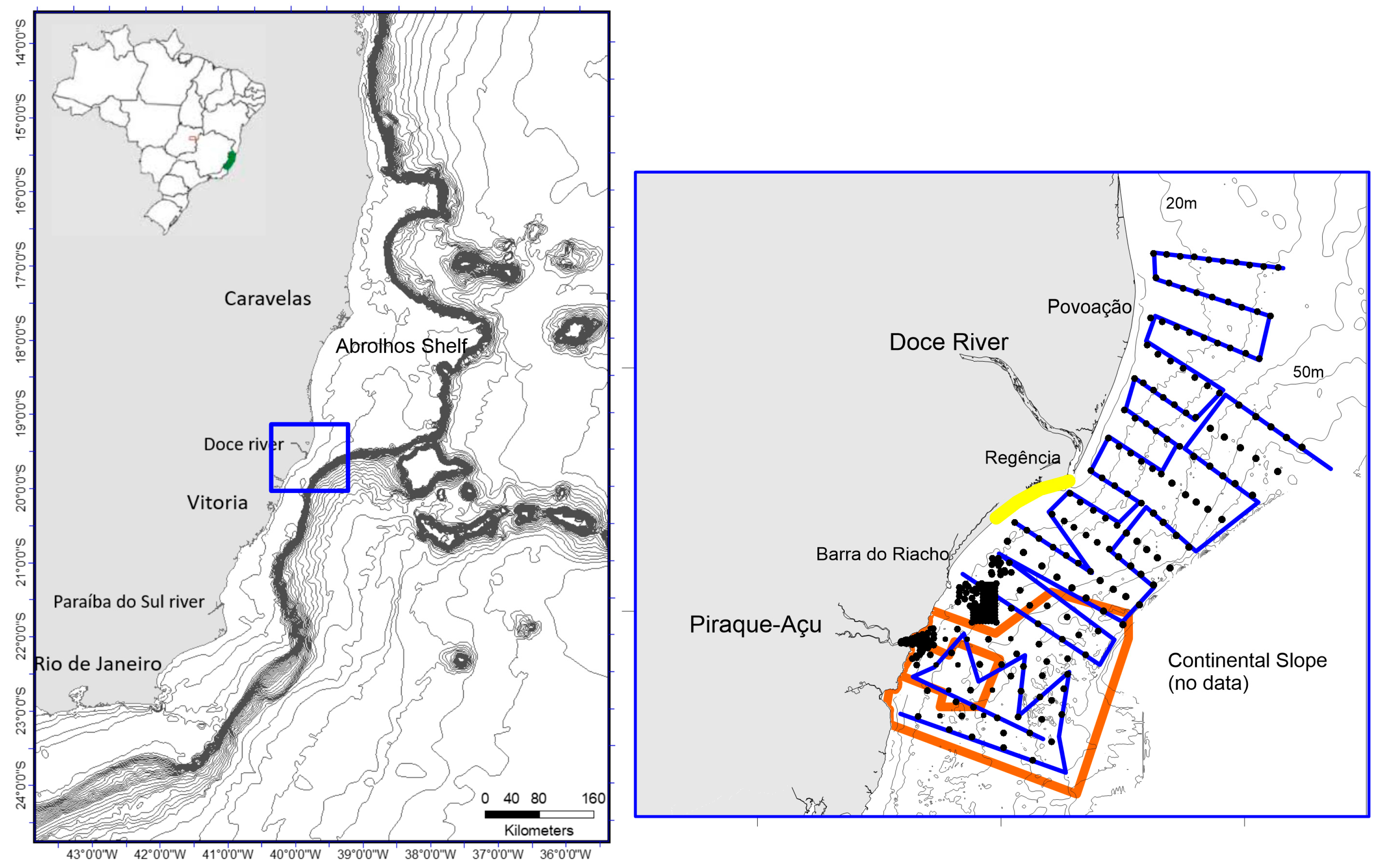
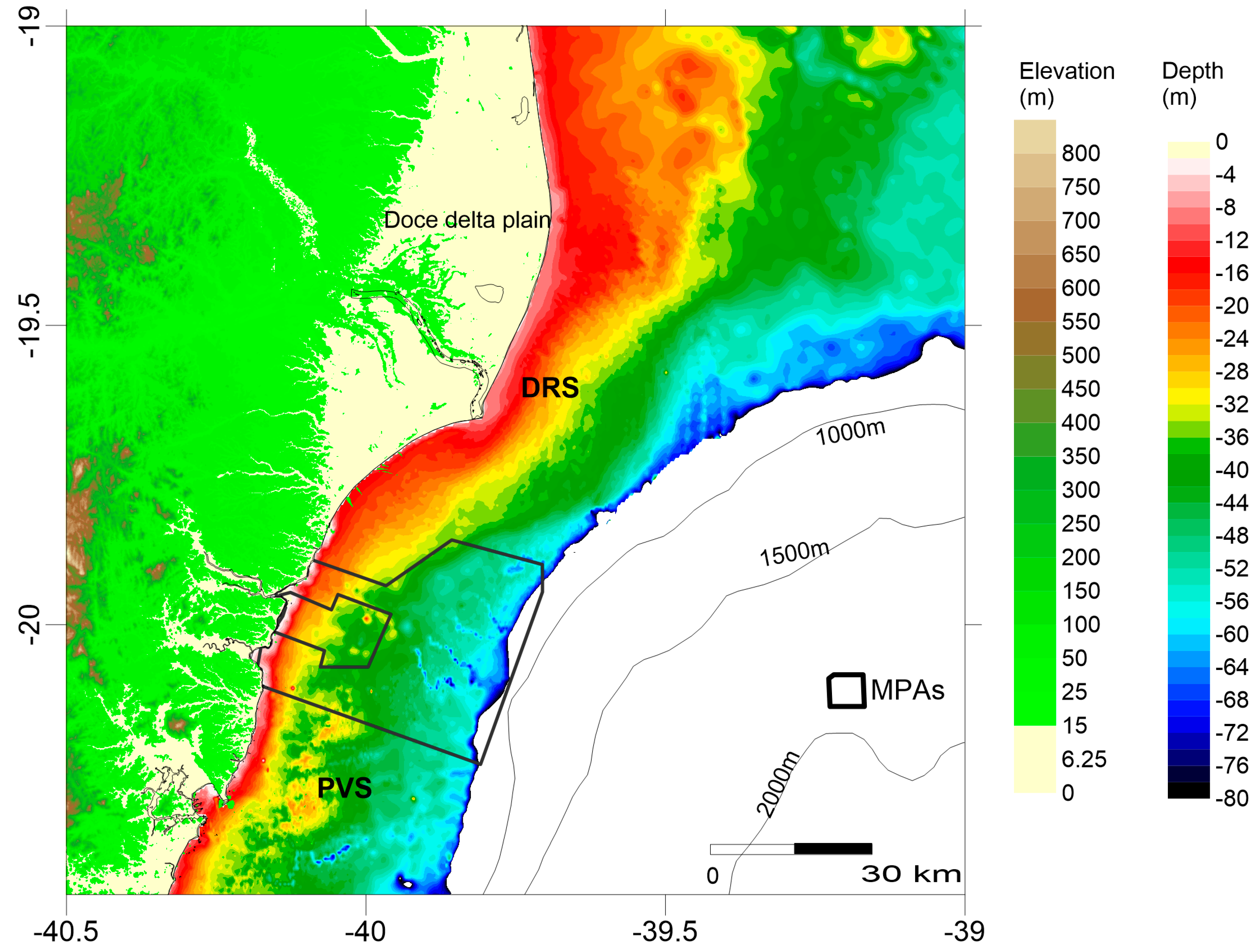
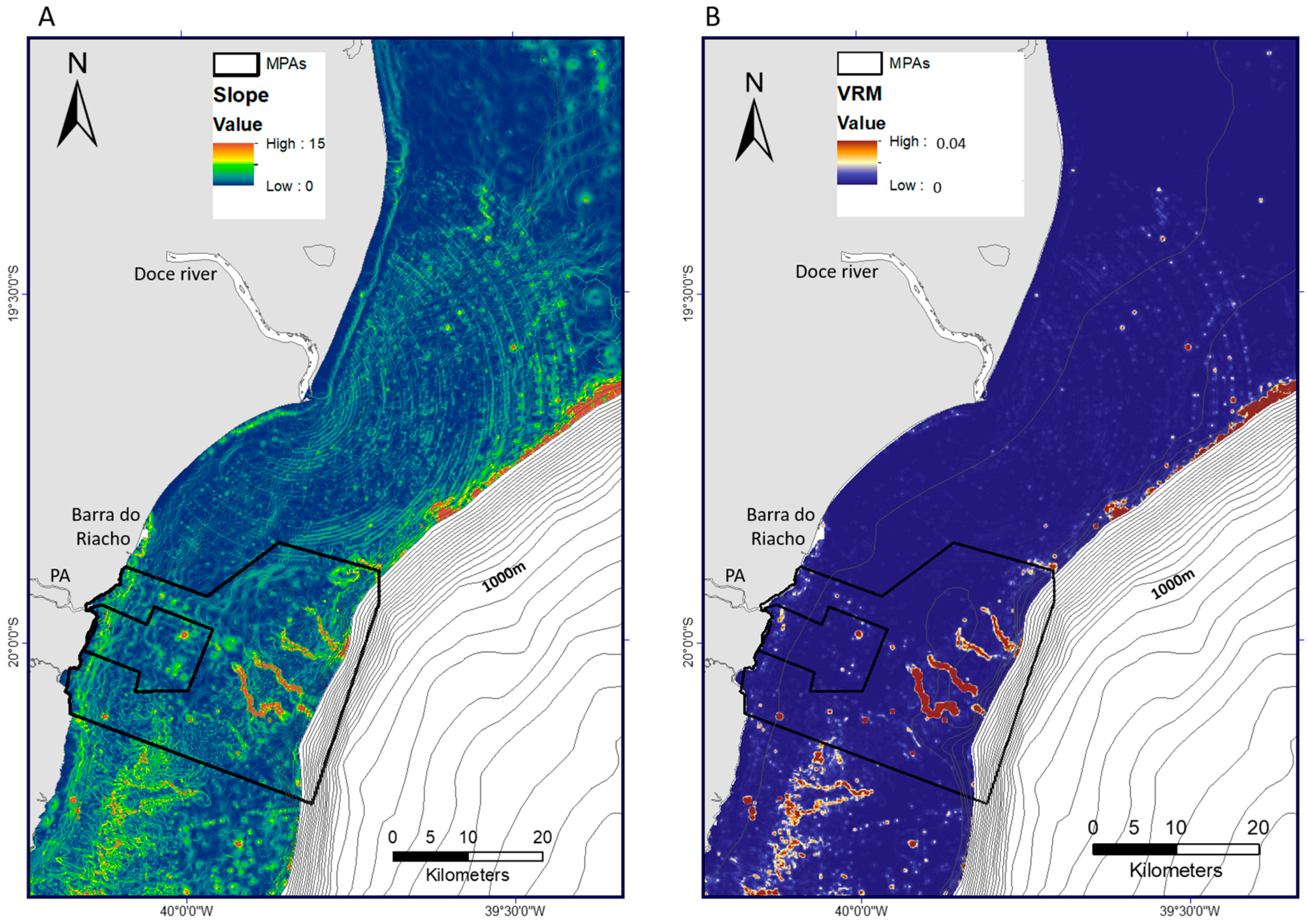

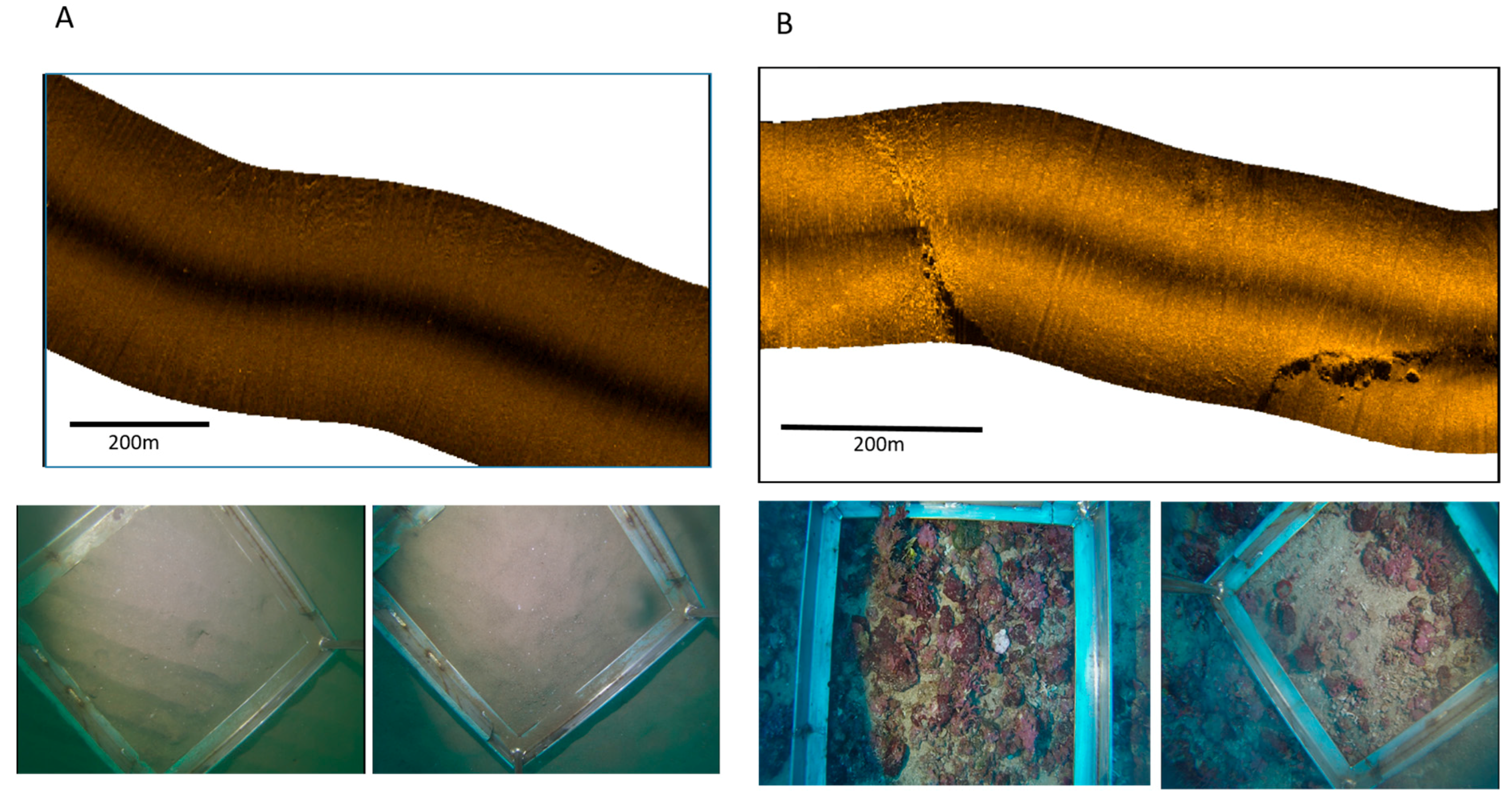
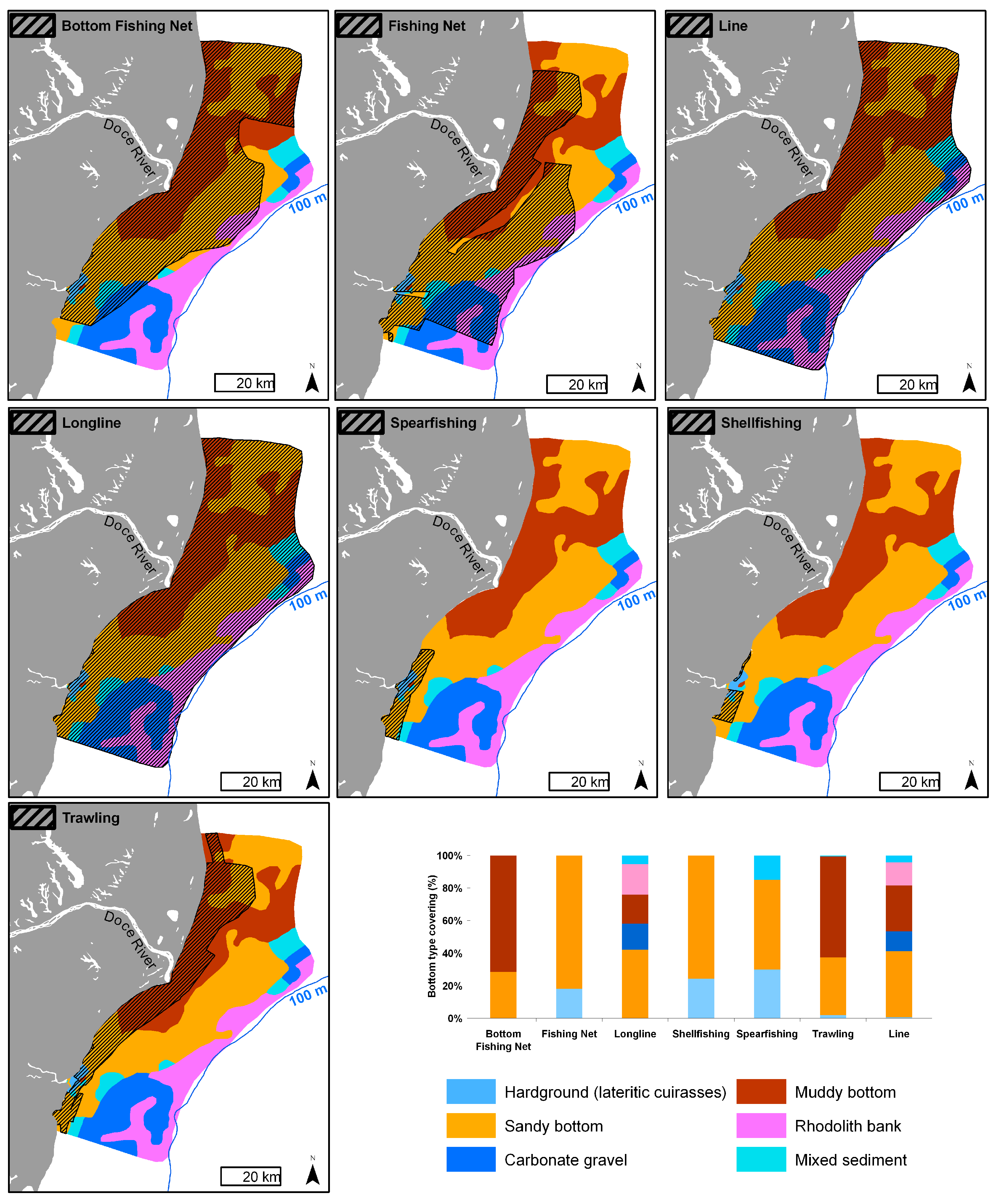
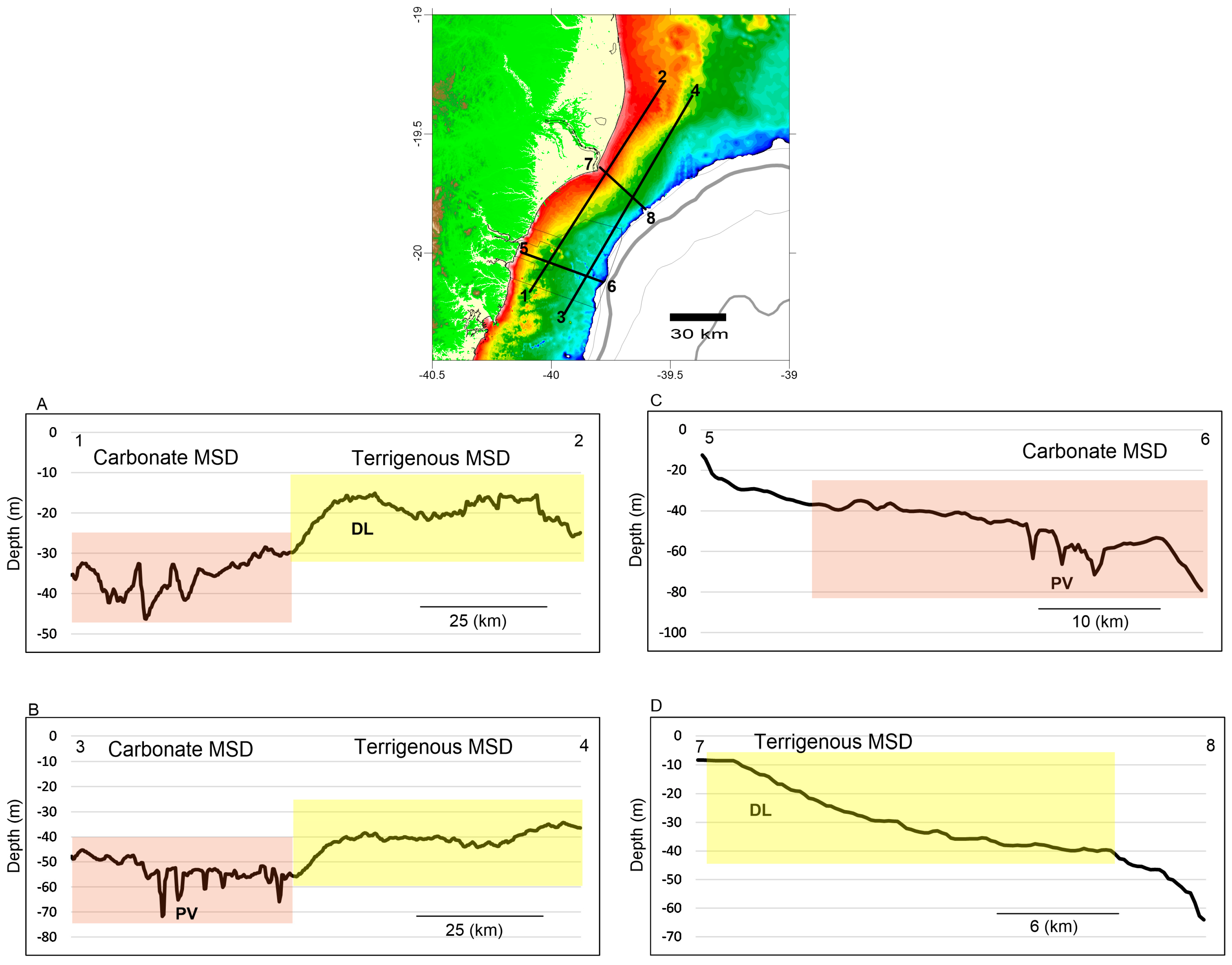
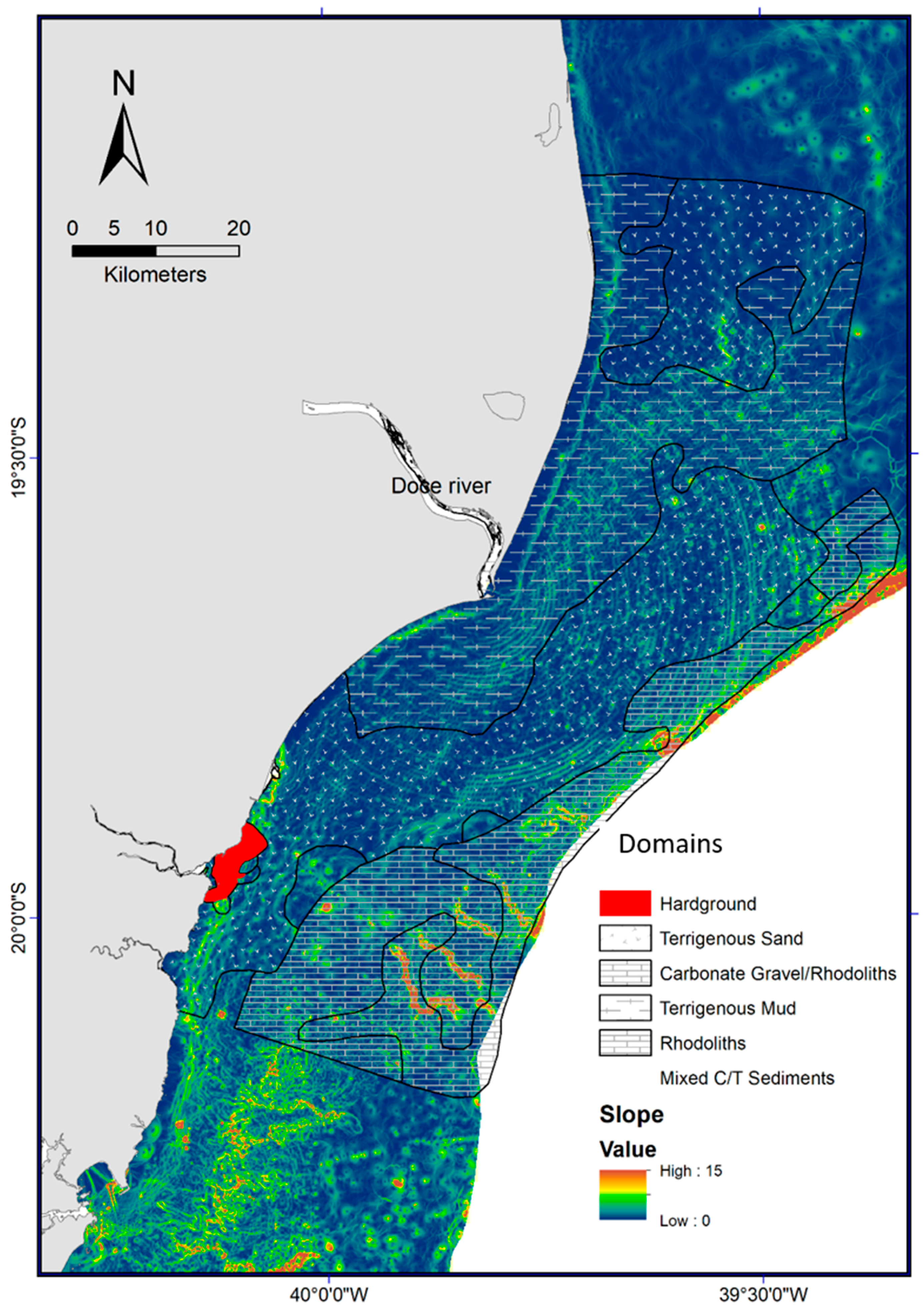
| Area (ha) for Each Fishery Type | |||||
|---|---|---|---|---|---|
| Trawlling | Longline | Angling | Dive | Gillnet | |
| Fishing Ground | 40,844 | 47,003 | 190,287 | 10,845 | 92,055 |
© 2018 by the authors. Licensee MDPI, Basel, Switzerland. This article is an open access article distributed under the terms and conditions of the Creative Commons Attribution (CC BY) license (http://creativecommons.org/licenses/by/4.0/).
Share and Cite
Bourguignon, S.N.; Bastos, A.C.; Quaresma, V.S.; Vieira, F.V.; Pinheiro, H.; Amado-Filho, G.M.; De Moura, R.L.; Teixeira, J.B. Seabed Morphology and Sedimentary Regimes defining Fishing Grounds along the Eastern Brazilian Shelf. Geosciences 2018, 8, 91. https://doi.org/10.3390/geosciences8030091
Bourguignon SN, Bastos AC, Quaresma VS, Vieira FV, Pinheiro H, Amado-Filho GM, De Moura RL, Teixeira JB. Seabed Morphology and Sedimentary Regimes defining Fishing Grounds along the Eastern Brazilian Shelf. Geosciences. 2018; 8(3):91. https://doi.org/10.3390/geosciences8030091
Chicago/Turabian StyleBourguignon, Silvia N., Alex C. Bastos, Valéria S. Quaresma, Fernanda V. Vieira, Hudson Pinheiro, Gilberto Menezes Amado-Filho, Rodrigo Leão De Moura, and João Batista Teixeira. 2018. "Seabed Morphology and Sedimentary Regimes defining Fishing Grounds along the Eastern Brazilian Shelf" Geosciences 8, no. 3: 91. https://doi.org/10.3390/geosciences8030091






